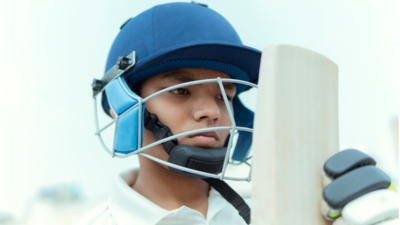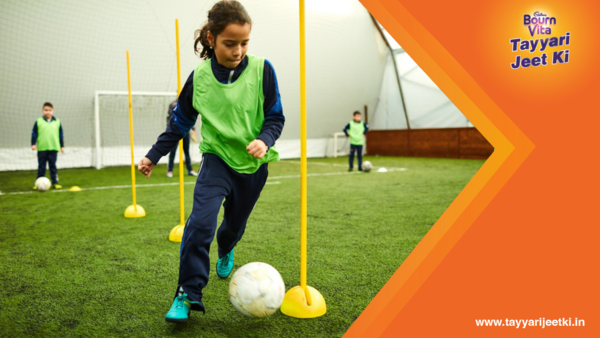Trending
This story is from November 28, 2023
Dr. Manjari Chandra explains Vitamin D deficiency in kids and how it can affect them
Muscle weakness or cramps, bone discomfort, fatigue, or depression are common signs of vitamin D deficiency. Children and infants can contract rickets due to a vitamin D deficit. The illness rickets results in weak, malformed, and thin bones.

In a recent multistate study, a stark reality emerged — more than 50% of children and adolescents face either vitamin D deficiency or insufficiency. It is well‐established that prolonged and severe vitamin D deficiency leads to rickets in children.
Therefore, consideration of potential corrective strategies to allow children and adolescents to maintain adequate vitamin D status throughout the year, even in the absence of adequate summer sun exposure, is vital.
Often hailed as the ‘Sunshine Vitamin,’ Vitamin D takes centre stage in a child’s health. It is a linchpin for calcium absorption, vital for sturdy bones, maintenance of calcium homeostasis and bone density, etc. While it plays a crucial role in bone development and is well known for that function, beyond bone health, it emerges as a key player in the regulation of cell differentiation and proliferation, cellular growth, immune system regulation, regulation of hormone secretion and even mood and behaviour through neurotransmitter regulation. Along with it, healthy Vitamin D levels in childhood set a stronger stage for healthier adulthood.
In a world where breathable air and harmless sunlight seem like distant dreams, obtaining adequate Vitamin D poses a challenge. In order to prevent vitamin D deficiency in children, these are the three concrete measures that can be taken by parents towards childcare:
Increasing sunlight exposure: Strategic sun exposure during early morning or late afternoon, coupled with outdoor activities, can be a great idea to obtain adequate amounts of the sunshine vitamin. While being outdoors, quality sunscreen with SPF 30 or higher can protect kids against sunburn and other harmful effects.
Fortification of food: Fortifying meals with vitamin D-rich ingredients and incorporating naturally rich sources like fatty fish such as sardines, herring, tuna, mackerel, salmon, cod liver oil, egg yolks, and mushrooms enhance dietary intake. In fact, India's rich traditional recipes, filled with ghee, deeply embedded in its cultural tapestry, not only provide substantial Vitamin D dosages but also enhance the bioavailability of Vitamin D due to its fat-solubility. If your child is a picky eater, they would need creative approaches to introduce Vitamin D-rich foods into their meals.
Vitamin D supplementation: When sunlight is insufficient or deficiency persists, supplements become essential. However, ensuring these supplements contain both Vitamin D (D3) and its absorption companion, Vitamin K2, is crucial. Your paediatrician is the right healthcare provider to recommend the correct vitamin D supplement dose for your child.

Vitamin D deficiency isn't a singular challenge; it is intertwined with various factors. In a country like India, where a wheatish complexion is prevalent, children with darker skin shades face reduced sunlight absorption. Premature birth, underlying medical conditions like inflammatory bowel syndrome or celiac disease, and even weight or fat percentage can impact one’s vitamin D levels. Inflammatory bowel syndrome or celiac disease, commonly known as gluten allergy, also leads to reduced absorption of nutrients from the gut, which may trigger Vitamin D deficiency. The commonality of symptoms related to vitamin D deficiency often leads to oversight, underlining the critical need for awareness.
Children experiencing fatigue, slow growth, delays in development, or weak immunity may signal an underlying vitamin D deficiency. While boys may exhibit signs of lesser muscular strength, girls might display mood and behavioural changes.
Low vitamin D levels in young children also increase the risk of hormonal imbalances, including parathyroid, testosterone and progesterone, among others. Imbalances may lead to PCOS and obesity in young girls, while it may compromise growth and maturation in boys.
Early detection becomes crucial in preventing related issues such as weakened immunity, rickets, developmental delays, and compromised cognitive abilities.
Paediatricians can screen children based on some risk factors and prescribe blood tests to those at higher risk.
Some common signs indicating a higher risk of vitamin D deficiency in children include:
Kids with vitamin D-deficient diets
Overweight or obese children and children with shorter height for their age
Children with darker skin tones (as darker skin is capable of synthesising less amounts of vitamin D received from sun exposure as compared to children with lighter skin tones)
Children with certain medical conditions, including type 1 and type 2 diabetes and certain gastrointestinal disorders, such as inflammatory bowel disease and celiac diseases, which can interfere with food absorption.
Ensuring regular checks and supplementation in high-risk groups may help in minimising the health risks of their vitamin D deficiency.
Certain segments of our population, where young children are mostly homebound or fully covered with clothing, put them at higher risk of deficiency. Ensuring boys and girls get an equal chance to play outdoors and expose their bodies to sunlight is crucial. As we move forward, it's crucial to bridge the awareness gap, fostering a collective responsibility to safeguard the well-being of our children.
Even when it is common to have vitamin D deficiency, its symptoms are usually overlooked because of a lack of awareness. If a child shows symptoms like fatigue, slower growth or delays in development, or if the child has weak immunity with recurring infections, it could indicate vitamin D deficiency or insufficiency. As parents, the responsibility transcends detection and prevention. We must weave the threads of cultural practices and health-conscious choices to ensure our children not only cherish their heritage but also thrive in the warmth of good health.
To check whether your child is getting adequate levels of vitamin D or not, check out www.tayyarijeetki.in.
Author:
Manjari Chandra, Founder BONATRA |
Consultant Functional Nutrition and Nutritional Medicine |
ManjariWellness, Max Healthcare, Metabalance
Disclaimer: This article is produced by the Times Internet Spotlight team for Spotlight Brand Studio.
Therefore, consideration of potential corrective strategies to allow children and adolescents to maintain adequate vitamin D status throughout the year, even in the absence of adequate summer sun exposure, is vital.
The role of vitamin D in the tapestry of life
Often hailed as the ‘Sunshine Vitamin,’ Vitamin D takes centre stage in a child’s health. It is a linchpin for calcium absorption, vital for sturdy bones, maintenance of calcium homeostasis and bone density, etc. While it plays a crucial role in bone development and is well known for that function, beyond bone health, it emerges as a key player in the regulation of cell differentiation and proliferation, cellular growth, immune system regulation, regulation of hormone secretion and even mood and behaviour through neurotransmitter regulation. Along with it, healthy Vitamin D levels in childhood set a stronger stage for healthier adulthood.
The crucial trio for vitamin D adequacy: Sunlight, fortified foods, and supplements
In a world where breathable air and harmless sunlight seem like distant dreams, obtaining adequate Vitamin D poses a challenge. In order to prevent vitamin D deficiency in children, these are the three concrete measures that can be taken by parents towards childcare:
Increasing sunlight exposure: Strategic sun exposure during early morning or late afternoon, coupled with outdoor activities, can be a great idea to obtain adequate amounts of the sunshine vitamin. While being outdoors, quality sunscreen with SPF 30 or higher can protect kids against sunburn and other harmful effects.
Fortification of food: Fortifying meals with vitamin D-rich ingredients and incorporating naturally rich sources like fatty fish such as sardines, herring, tuna, mackerel, salmon, cod liver oil, egg yolks, and mushrooms enhance dietary intake. In fact, India's rich traditional recipes, filled with ghee, deeply embedded in its cultural tapestry, not only provide substantial Vitamin D dosages but also enhance the bioavailability of Vitamin D due to its fat-solubility. If your child is a picky eater, they would need creative approaches to introduce Vitamin D-rich foods into their meals.
Vitamin D supplementation: When sunlight is insufficient or deficiency persists, supplements become essential. However, ensuring these supplements contain both Vitamin D (D3) and its absorption companion, Vitamin K2, is crucial. Your paediatrician is the right healthcare provider to recommend the correct vitamin D supplement dose for your child.

Unraveling the factors behind vitamin D deficiency
Vitamin D deficiency isn't a singular challenge; it is intertwined with various factors. In a country like India, where a wheatish complexion is prevalent, children with darker skin shades face reduced sunlight absorption. Premature birth, underlying medical conditions like inflammatory bowel syndrome or celiac disease, and even weight or fat percentage can impact one’s vitamin D levels. Inflammatory bowel syndrome or celiac disease, commonly known as gluten allergy, also leads to reduced absorption of nutrients from the gut, which may trigger Vitamin D deficiency. The commonality of symptoms related to vitamin D deficiency often leads to oversight, underlining the critical need for awareness.
Signs and symptoms of vitamin D deficiency in young ones
Low vitamin D levels in young children also increase the risk of hormonal imbalances, including parathyroid, testosterone and progesterone, among others. Imbalances may lead to PCOS and obesity in young girls, while it may compromise growth and maturation in boys.
Early detection becomes crucial in preventing related issues such as weakened immunity, rickets, developmental delays, and compromised cognitive abilities.
Vitamin D testing and monitoring
Some common signs indicating a higher risk of vitamin D deficiency in children include:
Kids with vitamin D-deficient diets
Overweight or obese children and children with shorter height for their age
Children with darker skin tones (as darker skin is capable of synthesising less amounts of vitamin D received from sun exposure as compared to children with lighter skin tones)
Children with certain medical conditions, including type 1 and type 2 diabetes and certain gastrointestinal disorders, such as inflammatory bowel disease and celiac diseases, which can interfere with food absorption.
Ensuring regular checks and supplementation in high-risk groups may help in minimising the health risks of their vitamin D deficiency.
Weaving cultural practices with health-conscious choices
Certain segments of our population, where young children are mostly homebound or fully covered with clothing, put them at higher risk of deficiency. Ensuring boys and girls get an equal chance to play outdoors and expose their bodies to sunlight is crucial. As we move forward, it's crucial to bridge the awareness gap, fostering a collective responsibility to safeguard the well-being of our children.
In a nutshell
Even when it is common to have vitamin D deficiency, its symptoms are usually overlooked because of a lack of awareness. If a child shows symptoms like fatigue, slower growth or delays in development, or if the child has weak immunity with recurring infections, it could indicate vitamin D deficiency or insufficiency. As parents, the responsibility transcends detection and prevention. We must weave the threads of cultural practices and health-conscious choices to ensure our children not only cherish their heritage but also thrive in the warmth of good health.
To check whether your child is getting adequate levels of vitamin D or not, check out www.tayyarijeetki.in.
Author:
Manjari Chandra, Founder BONATRA |
Consultant Functional Nutrition and Nutritional Medicine |
ManjariWellness, Max Healthcare, Metabalance
Disclaimer: This article is produced by the Times Internet Spotlight team for Spotlight Brand Studio.
End of Article
FOLLOW US ON SOCIAL MEDIA









